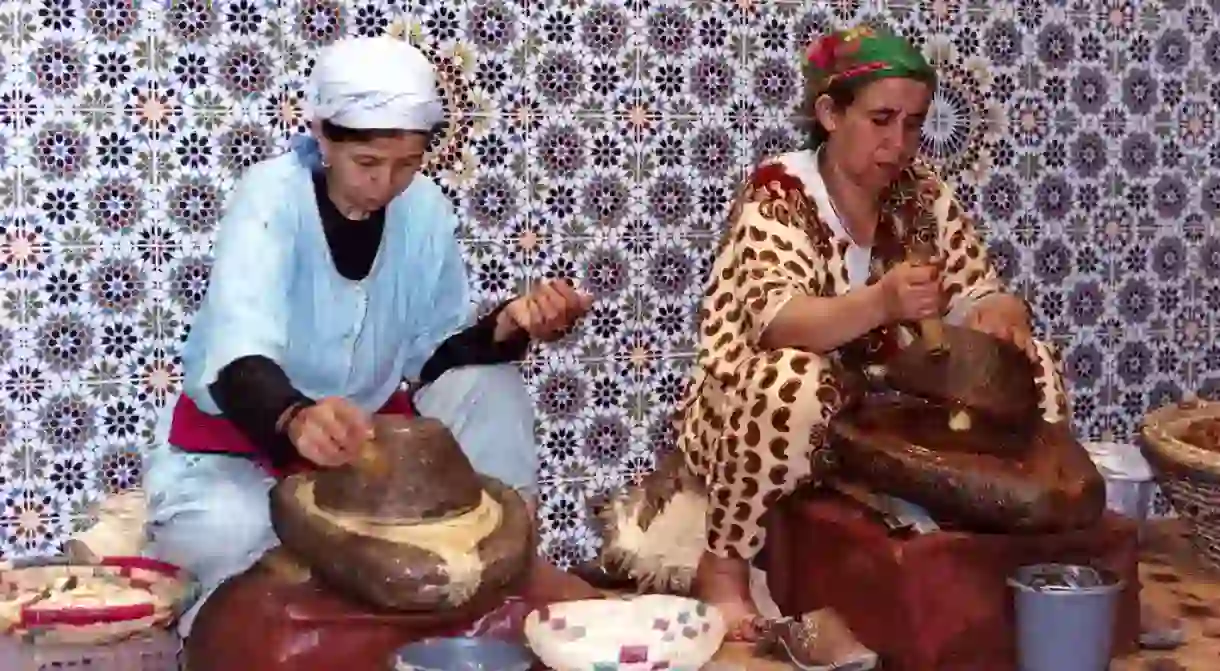What You Need To Know When Buying Argan Oil In Morocco

Used by the local Amazigh people of Morocco for its ability to help heal the look of scars and for soothing rheumatic problems – among many other beneficial qualities – argan oil today is one of the hottest beauty products on the market. It is widely available in spice shops throughout the medinas of Morocco, but the quality varies, as does the price. With few regulations guiding the ‘certified bio’ classification, one really has to know their argan oil facts to be sure it’s the real deal. Whether you’re out for its healing powers, or in need of a new nutty flavor for your culinary adventures, here’s what to look for when buying argan oil in Morocco.
Color and Consistency
True argan oil should be clear, although somewhat murky, but dull yellow in color. Anything too golden may indicate that the argan oil has been mixed with other oil varieties to keep costs low. After all, 30 kilograms of nuts are required to produce one kilogram of oil. The oil should be rather light when applied to the skin, and even though the skin may not absorb it quickly, over time it will. Oil that washes off in the shower the next day may not be of the finest quality or purest form.
Price and Packaging
As with concerns over purchasing edible goods in a plastic container, it’s best to buy and store argan oil in a glass bottle to avoid any contamination from the plastics. Expect to pay up to 200 Dirhams (roughly US $20) for a 150ml bottle of quality argan oil.
http://instagram.com/p/wXysrBIkHM/?tagged=sidiyassine
Preparation
For cosmetic purposes, the argan seed should be cold pressed to produce the oil; this is to retain the oil’s high Vitamin E properties. The fruit, a treat for the goats that roam the region and climb the straggly trees, was previously only compressed after the fruit passed through the goat’s digestive system and collected from its dung. Today, the process is much more hygienic, with technology streamlining the process from the time the fruit is collected.
http://instagram.com/p/BGUqTpnrUTQ/?tagged=sidiyassine
Know your brands
Sidi Yassine just outside of Essaouira produces the best argan oil, where the highest standards are used to produce the finest cosmetic and culinary oils. The company’s oil is also certified organic based on international standards. While it is not possible to visit the farm where the oil is produced, fine boutiques throughout Morocco, including 33 Rue Majorelle in Marrakech and Histoires des Filles in Essaouira stock the oil. Unfortunately, many of the so-called ‘argan cooperatives’ which exist throughout the medina and line the route leading to Essaouira – where women grind the fruit by hand to produce the oil before travelers’ eyes – do not produce the finest quality products.
http://instagram.com/p/BLwNYb7DZg8/?taken-by=arganicldn
Culinary versus cosmetic
It is possible to use cold-pressed argan for both cosmetic and culinary purposes by using the raw kernels, however toasted argan kernels are used only to produce culinary oils. With its smooth, nutty taste, the culinary version is perfect for cooking or dipping, or even tossed over salad or grilled vegetables. Research has shown that it is effective in cholesterol reduction, while it is also one of the main ingredients in locally blended amlou, a nut butter made from argan oil, honey and almonds, all of which are local to the area.
http://instagram.com/p/BLL7ZALDlqU/?taken-by=arganicldn













